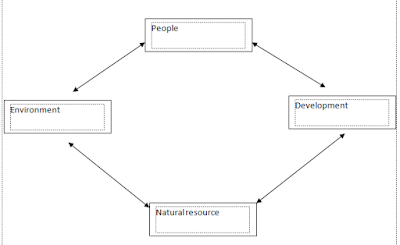Population – Environment interactions in Bangladesh
Bangladesh is one of
the most densely populated country in the world. Population growth rate is much
higher than its carrying capacity. As population enlarges, there is smaller
amount of per person natural resources such as water, arable land and forest.
More people mean more exploitation of natural resources leading to degradation
of environment.
Figure:
Inter linkage among man, environment and natural resource
A very simple
interaction between population and environment is that high growth of
population may lead to over consumption of natural resources and degradation of
ecosystem and environmental potentials but this relationship could be further
aggravated by a number of other social factors which include the following:
- The economic systems based on high rates of resources consumption, environmentally damaging trade practices and lack of environmental accounting;
- Widespread poverty and unsustainable development efforts;
- Women’s inequity and the large unmet need for quality reproductive healthcare and family planning;
- Lack of educational, employment and income opportunity;
- Under-utilization of environmentally sound and locally appropriate technology; and
- Lack of people’s participation in resources management and inadequate understanding of people about the natural systems (WWF, 1986).
Human interaction on
environment in Bangladesh can be categorized as follows;
Land
Degradation
The land is the most
important resource in Bangladesh and it is under intense use threatening its
carrying capacity. The pressure of population on land is a crucial factor in
the management of land resources in the country. Availability of land is a major
constraints in Bangladesh as virtually all available land is utilized for crop
production, homestead, commercial establishment, road network, urban
development, forestry, fishing etc. The country lacks a comprehensive landuse
policy emphasizing the most appropriate and productive use of land. Degradation
of soil fertility due to indiscriminate and inefficient use of chemical
fertilizer and pesticides and river erosion are posing treats for both
sustainability of agricultural and human habitation in Bangladesh.
There are a number of
ways in which population increase impinges on land quality. Firstly, by
increasing use of chemical inputs like fertilizers and pesticides, the
productivity of once fertile land has been affected in many areas. Secondly, by
increasingly converting marginal lands (e.g. chars, deforested lands, converted
wetlands, etc.) to crop cultivation they affect both the natural ecosystems as
well as the productivity of such marginal lands. Thirdly, pressure is increased
on non-crop ecosystems such as forests and wetlands to convert them to
croplands. Thus for examples large parts of the floodplains have been converted
from natural wetlands to relatively dry-lands for crop (usually rice)
cultivation by building embankments.
Water:
Problems of Scarcity and Abundance
Bangladesh has two
problems with water i.e., scarcity of water for agriculture, industrial and
domestic uses in the dry season and sometime, abundance of water in monsoon
causes flood and natural hazards. But people treat normal flood as boon rather
than bane. It is viewed that the country would face serious scarcity of fresh
water for agriculture, industry, fisheries and other livelihood activities in
near future.
Three things happen;
flow of up-stream water is decreasing and ground water level is going down
particularly in the dry season and at the same time, saline water is intruding
in the inland area.
The water development
and flood control projects have serious negative impacts on wetlands, fisheries
and on the ecosystems of some parts of the country. Major environmental concerns in water sector
include; degradation of wetlands, floodplain and water bodies, declining of
ground water, non-availability of water for irrigation, water pollution, water
logging, river bank erosion and flood damages.
Depletion
of Open water Fisheries
One of the important
resources of the country while has been badly depleted in the last few decades
is the open water fishery. This has been due to several reasons. Firstly, there
has been a net loss of open water fishing areas due to embankments of
floodplains is many parts of the country. Secondly, the number of fishermen has
increased putting greater pressure on the already shrinking open water fishing
area. Thus the fish catch and the important species has declined drastically in
most open water fisheries in Bangladesh. Fortunately, there are attempts to
protect the open water fishing ecosystems while improving the fish catch which
are beginning to show sign of success.
Forest
and Bio-diversity
Population pressure is
often cited as a primary reason for encroachment of forest areas and conversion
to crop lands. While this is no doubt true, there are many instances of people
(especially tribal) living in harmony with forests while protecting and
consuming them. Unfortunately, such traditional practices have been lost and a
more commercial approach to forest exploitation has led to large-scale
deforestation in Bangladesh over the last several decades. Fortunately there
are also some success stories in re-afforestation specially is the coastal belt
and also social forestry where people grow and look after trees not only in and
around forests but also in villages, road sides, etc. This has been a very
successful initiative involving government, NGOs and many other partners.
Energy
Crisis
The rural population of
Bangladesh is still heavily dependent on biomass for fuel for cooking. This has
led to depletion of biomass and indeed to the loss of organic matter in the
soil as animal and crop waste is need more and more for fuel. Efforts to grow
more biomass are being promoted but have not yet had any major impacts. Other
sources of renewable energy also need to be explored.
Health
and Sanitation
In addition to clean
drinking water safe disposal of waste has been an area of emphasis,
particularly in combating diarrheal diseases. While there has been some success
in promoting pit latrines by government as well as NGOs there is still a long
way to go before it takes a critical turn. Contamination of water still remains
the major source of disease and morbidity in the country. High population
density compounds the health hazards from lack of adequate sanitation.
Natural
Hazards
Natural hazards such as
floods, cyclones, droughts etc. have some of the worst impacts on people, specially
the poor who tend both to live in the more hazard prone zones as well as have
less capability to withstand such hazards. This is perhaps the issue on which
population growth leads to greater vulnerability to natural hazards of
different kinds. Despite efforts at improving working capabilities and
protection still too many people remain prone to such impacts.
Pollution
of Air and Water
The population in urban
centers is going several times faster than rural population and the proportion
of poor in the urban centre is also very high. They, thus become prey to
specific problems of the urban environment, which the rural poor do not have to
face. One such problem is air pollution from vehicular emission, which produces
not only particulate but also leads, which can affect babies and children.
Other hazards include water pollution and social waste generation, which the
urban population has to face every day.
Growing
Slums
The growth of slums
appears to be the direct outcome of the growth of urban population because of
rural to urban migration pushed by the rural poverty and unemployment. About
30% of the city dwellers are living in over 1200 slums in Dhaka City. The
situation is more or less same for the other cities. The slums houses are made
of poor construction materials such old CI sheets, wood, bamboo, straw, sack
and polythene.
Problem
of Waste Disposal
The disposal and
management of solid waste in the cities of the country, particularly in Dhaka
have become a huge problem and it degrades the city environment posing serious
health threat to the millions of city dwellers. Under the present system, solid
waste generated in household or premise is deposited by the citizens in the
roadside bins maintained by the City Corporation and then their staffs collects
and transport the waste to the disposal areas. But the service of the City
Corporation is very poor. An associate
problem with solid waste disposal is that as the garbage is dumped at the road
side, the city urchins and garbage collectors spread the piles of garbage and
scatter it around the bins and pick up some necessary items which they sell to
the market for recycling them. The danger is the pickers bear serious health
threat. There are also harmful industrial effluents and most of the industrial
establishments, in the country, do not have proper waste treatment plant.
Tannery waste has become one of the deadliest problems for the dweller in
Hajaribag and Rayerbazar areas in Dhaka.


Comments
Post a Comment